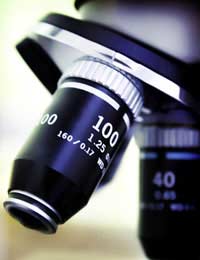Using Microscopes to See Bacteria

Bacteria are too small to see individual bacterial cells with the naked eye. Before the invention of microscopes in the renaissance in Europe, people did not understand what caused infections. It took a great deal of time and debate before the germ theory of disease was accepted in the 1900s, and into the 20th century before people realised that infections could be caused by viruses and fungi as well as by bacteria.
Several different forms of microscope can be used to view bacteria, from the simple light microscopes that are similar to early microscopes to incredibly sophisticated electron microscopes and scanning electron microscopes that can focus in on every detail of the bacterial cell using stunning levels of magnification.
Looking at Bacteria with a Light Microscope
Most children at school get to use a microscope but to look at plant and animal tissue, rather than bacterial cells. This is partly a safety issue but it is mainly also to do with the lack of proper equipment in schools. Growing pure cultures of bacteria needs special sterile techniques and incubators, which most schools don’t have. The first sight of bacteria that most biology students have is at university.Bacteria taken directly from an agar plate or culture where they have been grown are still relatively invisible. Staining techniques are used to make the colourless bacteria show up and the light microscope can show whether a bacterium is a coccus – a cell that is spherical, or a bacillus, a rod shape. Different stains can also show whether the bacterium has a capsule or not. This can be important because bacteria that do have a capsule tend to be more virulent. The Neisseria meningitides, the bacterium that causes some types of meningitis has a particularly thick capsule and this protects it from the human immune system.
Bacteria can be stained to show whether they are gram positive or gram negative, using the Gram stain. This is a simple test to do and knowing this helps doctors to decide how to treat the bacterial infection. Some antibiotics are not effective against both types.


Re: Friendly Bacteria in the Digestive System
hello, thankyou for this website it was very helpful
Re: Friendly Bacteria in the Digestive System
nope im leaving now goodbye , mumm! crimble crumble ready?
Re: Friendly Bacteria in the Digestive System
The meat out of the bin is perfectly fine jackie!
Re: Friendly Bacteria in the Digestive System
Yeahhh jim not the right time were quite busy at the moment
Re: How Can People Catch Lyme Disease?
My symptoms of Lyme disease occurred in 2017, but was diagnosed in 2019. I had severe symptoms ranging from headache,…
Re: Friendly Bacteria in the Digestive System
kids
Re: Friendly Bacteria in the Digestive System
i like kids
Re: Friendly Bacteria in the Digestive System
I have yo kidz. i have the basement kids
Re: Friendly Bacteria in the Digestive System
oh god im out
Re: Friendly Bacteria in the Digestive System
uhm